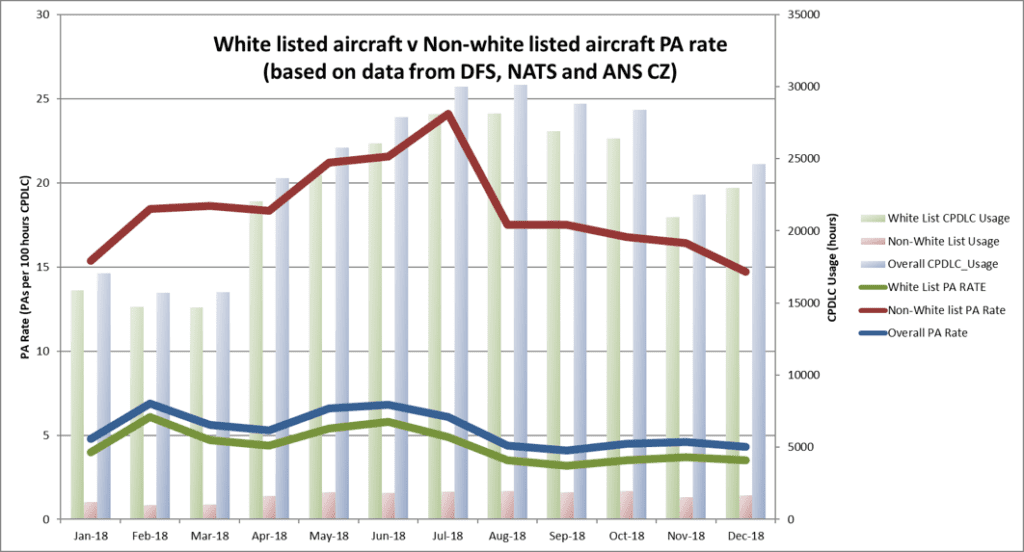
Eurocontrol plans to leave its current CPDLC black, white and gray avionics listing policy in place for the long term. Photo: Eurocontrol
Eurocontrol recently changed the way operators apply for classification of their aircraft to the operations ready list for the use of controller to pilot data link communications (CPDLC) in certain areas of European airspace under a six-year old regional policy. The air traffic management service provider confirmed details about the policy in an emailed statement to Avionics International, and placed it in context for the region’s operators long-term.
First established as the black-and-white list avionics policy — now termed the “OPS ready list” — in December 2013, by Maastricht Upper Airspace Control (MUAC) and later adopted by Skyguide and DSNA, Eurocontrol uses the policy as guidance to operators looking to use CPDLC in place of voice communications in certain European airspace. The black list includes a set of avionics observed by Eurocontrol to be incapable of adequately logging onto the European VDL mode 2 network, which is used for domestic CPDLC operations in Europe. These are known as systems with a higher provider abort (PA) rate, which occurs when there is a lack of air-to-ground connectivity for more than six minutes, leading to a service loss, according to the Single European Sky ATM Research Deployment Manager (SESAR DM).
The OPS ready list includes avionics that do not suffer from higher PA rates. The PA rate is calculated by the Data link Performance Monitoring Function (DPMF) of Eurocontrol using data provided by a number of air navigation service providers (ANSPs) in the region, including MUAC, Skyguide, NATS, DFS, the ANS Czech Republic and Slovenia Control.
“The process for applying for the white list has recently changed. Previously operators used to send the DPMF a spreadsheet containing information about their aircraft but now the process is handled online via the DPMF OneSky Team website which allows the operators to enter the data for their aircraft directly,” a representative for Eurocontrol said. “The white list is updated for each AIRAC cycle (so every 4 weeks). The number of aircraft added each month varies, but is typically 100 to 200 aircraft.”

Eurocontrol regular updates a ‘wiki’ that features information about the policy, including when it will accept applications. This is the latest application date information published by Eurocontrol. Photo: Eurocontrol.
Eurocontrol’s DPMF division analyzes the performance of various combinations of VHF data radios (VDR) and communication management units (CMU) on a monthly basis and discusses the results with the above-mentioned ANSPs to determine when to change the black list criteria. Avionics manufacturers of new systems being added to the list are advised when their systems are black-listed and what information is still required to understand the underlying cause on an ongoing basis.
The number of systems added to each list is constantly changing also based on how much data becomes available, Eurocontrol said. As an example, the VDR and CMU configuration featured on the Airbus A220 was recently added to the black list category as a result of a larger operator in Europe that started to fly the aircraft and thus allowing the DPMF to observe more provider aborts.
“The white list is likely to remain in place until such time as the majority of aircraft avionics have been updated to the latest versions that can perform acceptably well,” according to the Eurocontrol representative. “There are improvements in the communications network as well but the blacklist is targeting the poorly performing avionics so until the avionics have been updated to the latest version the white list is likely to be required by the ANSPs.”
As this policy continues for the long-term, the last SESAR DM update on the performance of the data link ground station network came in August 2018. The agency cited progress dropping to the lowest number of PAs since the stations were first implemented, as the performance became such a challenge in 2015, when the European Commission was forced to delay the European airspace CPDLC mandate from February 2015 to February 2020.
Commission Implementing Regulation (EU) 2015/310 requires legacy aircraft flying above 28,500 feet (FL 285) to be equipped with Aeronautical Telecommunications Network (ATN) or a router, antenna, CPDLC messaging interface and device, alerting system and a VHF Data Link (VDL) Mode 2 radio by Feb. 5, 2020.
Correction: This article has been updated to reflect the requirement for aircraft to be equipped ATN, not FANS 1/A, by Feb. 5, 2020 under the implementing regulation 2015/30.